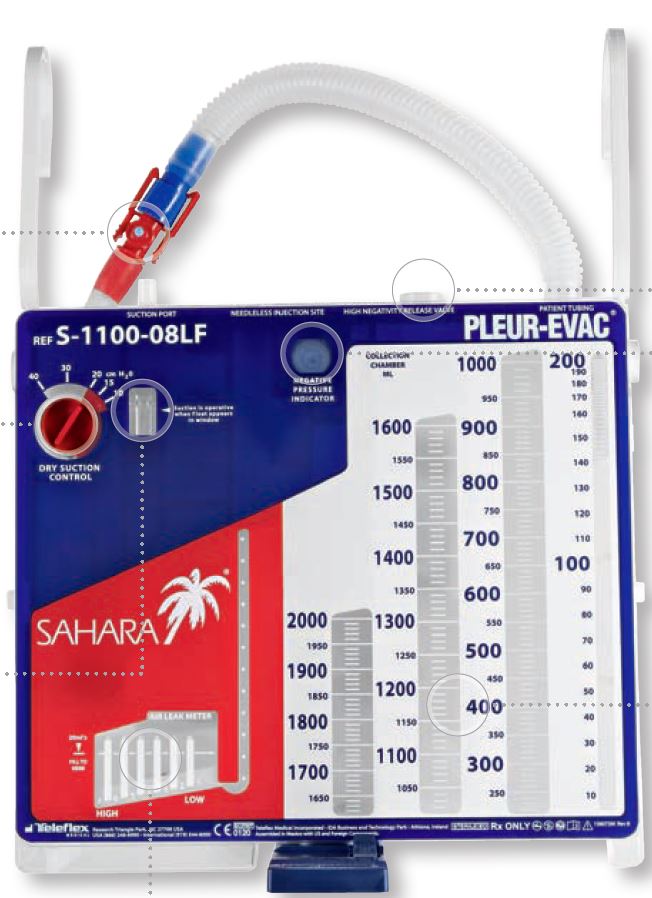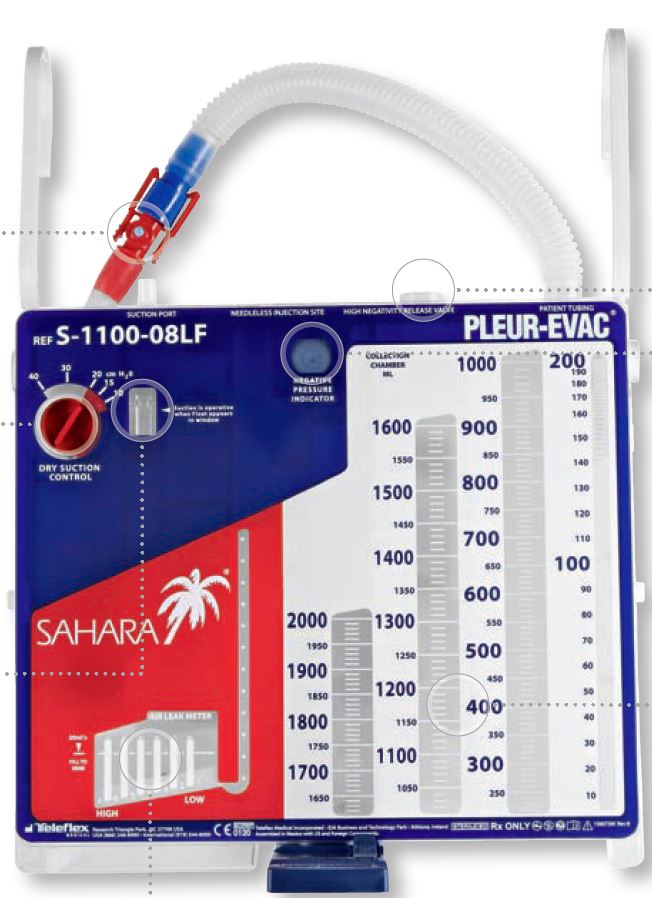PLEURAL DRAINAGE SYSTEM dry, 1X2L, ster. (Pleurevac S1100)
Valid Article
PLEURAL DRAINAGE SYSTEM dry, 1X2L, ster. (Pleurevac S1100)
Definition
Disposable pleural drainage system with dry suction and dry seal.
Patient air can exit through a valve which opens automatically on expiration and then immediately closes to prevent atmospheric air from entering during inspiration.
Specifications
Technical specifications
- Adult single collection chamber, capacity = 2000 ml. with calibrated measurement scale: / 2ml up to 200 ml, / 10ml up to 2000 ml
- Airflow capacity: 14 – 16 l / min
- Dry seal: application without water = no noise = ready for immediate use
- Patient protection: integrated one-way valve prevents reflux, is reliable, even when unit tips over
- Dry suction: control dial can be adjusted from -10 to -40 cm H2O
- Autotransfusion possible: locking autotransfusion connectors with selfsealing ports for direct collection sampling (without a needle). Can be connected to the Pleur-evac autotransfusion bags.
- Air leak meter: optional filling of the air leak meter with water makes it possible to quantify air leaks, facilitating a diagnosis of pneumothorax. indicates the degree or air leak from 1 (low) to 7 (high)
- Needleless sampling port in the connector
- Color-coded ATS connectors and clamp-on drainage tube allow for quick and easy unit replacement.
- Sterile, for single use
Packaging & Labelling
Unit sterile packaging in peel-open pack
Instructions for use
Refer to the Instructions For Use for full operating and set-up instructions.
Setup instructions
Connect patient drainage tube to thoracic catheter to establish one-way seal for patient protection
For air-leak diagnostics, add pre-packed 20ml sterile fluid to air leak meter through needleless injection site. fill to 20ml line. (the fluid is not a water seal)
If suction is required, connect the suction source to suction port. If gravity drainage is prescribed, suction port should remain uncapped and free of obstruction
Adaptation of suction
The unit is preset at -20cm of water
Rotate the dial to the prescribed suction level. The dial clicks in place. Increase source suction until the orange float appears in the indicator window. Source must be capable of delivering a minimum of 6 liters per minute airflow.
If the orange float falls out of the indicator window, the suction must be increased. If the orange float still does not appear: check to make sure that all connections are secure and the suction tubing is not kinkedn clamped or occluded.
Use of the negative pressure indicator
During gravity drainage, the negative pressure indicator may intermittently indicate a negative pressure in the collection chamber with patient respiration. During suction drainage, the pressure indicator should indicate a negative pressure continuously.
The negative pressure indicator does not confirm drainage tube patency.
Use of the high negativity relief valve
When suction setting is changed from a higher to a lower setting, the patient negativity may remain at the higher level unless the negativity is relieved. Use the filtered high negativity relief valve located at the top of the unit to reduce patient negativity to desired level. Depress the button to manually rekief excess negativity.
Caution: if suction is not operative, or if operating on gravity drainage, depressing the high negativity relief valve can reduce negative pressure within the collecytion chamber to zero (atmosphere), with the resulting possibility of a pneumothorax.
Use of the high positive pressure relief valve
The positive pressure relief valve opens automatically with increases in positive pressure if the suction tube or port is blocked, minimizing the risk of tensio pneumothorax. Negative pressure is limited to +/- -50 cm of water.
Use of the air leak meter
The patient air leak meter quantifies the size of an air leak from 1 (low) to 7 (high). The higher the numbered column through the bubbling appears, the greater the magnitude of the air leak.
Precautions for Use
- The drainage system must be placed below the patient's chest at all times.
- Avoid positions that create loops in patient tubing.
- If clamping is necessary, clamp near the color-coded auto-transfusion system connector.
MSF requirements
Indicated for pneumothorax, hemopneumonthorax, broncho-alveolar fistulas.
Especially needed for none-resolving pneumothorax. It would be safer and better for patient to apply suction rather then put in another chest tube.





![[EMEQDBOT2--] BOTTLE, thoracic drainage, 2 l autoclavable + lid 2 tubes](/web/image/product.template/572941/image_256/%5BEMEQDBOT2--%5D%20BOTTLE%2C%20thoracic%20drainage%2C%202%20l%20autoclavable%20%2B%20lid%202%20tubes?unique=94b6130)